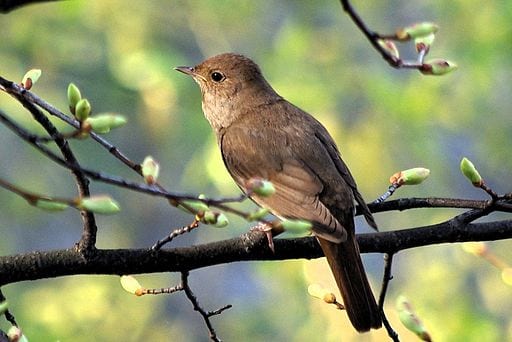Nightingales in Literature
View more in London in Song | "A Nightingale Sang In Berkeley Square"
In “A Nightingale Sang in Berkeley Square,” the song of the nightingale is unbelievable and impossible. It is something that cannot happen, which, indeed we’re encouraged to think didn’t happen:
I may be right, I may be wrong
But I’m perfectly willing to swear
That when you turned and smiled at me
A nightingale sang in Berkeley Square.
By admitting this element of doubt, and by declaring his willingness to swear, it becomes clear to the audience that there was no nightingale. The imaginary presence of the nightingale in the center of London, is merely an effect of the intoxication of the lover. But why, of all the birds that don’t belong in the city, is it the nightingale specifically that the lover imagines hearing?

Nightingales are known for the beauty of their song, an impression which perhaps has less to do with the actual noises nightingales make and more to do with their mythic status, promoted throughout history by their association with poetry. As Michael Ferber helpfully explains: “The nightingale has had the most spectacular career of all literary birds. It has appeared in many thousands of poems from Homer to the twentieth century, and even in ancient times it acquired an almost formulaic meaning as the bird of spring, of night, and of mourning. Later, through its link to spring and night, it also became a bird of love.”[1]
Most commonly, the nightingale is understood as a sign of the coming spring, its song ushering in new leaves after the winter. In the “Odyssey,” for example, Homer describes a nightingale singing in the woods “when springtime has just begun” (Odyssey 19.519). But the Greeks also heard something melancholy in the song of the nightingale, and it became associated with mourning.
Ovid tells a version of the Philomela myth (Philomela was Greek for nightingale) which connects the nightingale to both mourning and violence. In this version, Philomela is raped by her sister’s husband Tereus, who then cuts out her tongue to prevent her from speaking and locks her in a cottage. She manages to contact her sister by weaving a message on her loom. Her sister comes to rescue her, and then together the two sisters get their revenge by killing Tereus’s son and feeding the flesh to Tereus for dinner. The sisters then escape by turning into birds. Versions of this Ovidian story can be found in Chaucer’s “The Legend of Good Women,” Shakespeare’s “Titus Andronicus,” John Keats’s “Eve of St Agnes,” and T.S. Eliot’s “The Waste Land.”
In English literature, the nightingale is often paired with the lark, the former as the songbird of the night, and the latter the songbird of the morning. Perhaps most famously this happens when Romeo and Juliet, after spending their one night together hear a bird, and debate whether it is nightingale or a lark (“Romeo and Juliet,” 3.5). Milton, too, frequently mentions the nightingale in “Paradise Lost,” where it appears as a wakeful bird who is hidden in the dark. Milton also associated the nightingale with lovers, and calls the nightingale’s song “amorous.”
The connection between the nightingale and the poet, both as singers, is explored most fully in the Romantic period. In his “Defence of Poetry,” Percy Bysshe Shelley writes, “A Poet is a nightingale, who sits in darkness and sings to cheer its own solitude with sweet sounds; his auditors are as men entranced by the melody of an unseen musician, who feel that they are moved and softened, yet know not whence or why.” Samuel Taylor Coleridge, meanwhile, in his poem “To the Nightingale” complained that too many poets kept banging on about nightingales “How many wretched Bards address thy name” and in “The Nightingale,” challenges the idea that the nightingale song is mournful: “In nature there is nothing melancholy.” In “Ode to A Nightingale,” John Keats similarly presents the nightingale as laughing — happy because she is ignorant of human suffering.
By the time Michael Arlen wrote “A Nightingale Sang in Berkeley Square,” the idea of the nightingale was a hackneyed cliché, and could only be deployed if it positively drips with irony — as indeed it does in both Arlen’s story and the song by Eric Maschwitz and Manning Sherwin.
[1] Michael Ferber, A Dictionary of Literary Symbols, 3rd edition (Cambridge University Press, 2017)
3 minutes
